Guidance on the Regulations on the Marketing of Virtual Assets and Related Activities 2024
Introduction
The Dubai Virtual Assets Regulatory Authority (VARA) was established and authorised by Law No. (4) of 2022 Regulating Virtual Assets in the Emirate of Dubai (Dubai VA Law) to regulate Virtual Assets and Virtual Asset Service Providers (VASPs).
This Guidance on Regulations on the Marketing of Virtual Assets and Related Activities 2024 (this Guidance on Marketing Regulations) is issued pursuant to the Virtual Assets and Related Activities Regulations 2023 (the Regulations) and the Regulations on the Marketing of Virtual Assets and Related Activities 2024 (the Marketing Regulations).
The purpose of this Guidance on Marketing Regulations is to provide guidance on the application of the Marketing Regulations, including, but not limited to, when the Marketing Regulations apply, general requirements applicable to all Marketing and the exemptions which are available. This guidance is provided both by way of indicative examples and explanations of phrases which have specific meanings in the Marketing Regulations.
As per Regulation I.B.4, all Guidance is indicative and non-binding, and may comprise any information as further elaboration or explanation on the application of Regulations, or any Rules or Directives only. This Guidance on Marketing Regulations is not a substitute for the Marketing Regulations or independent legal advice. Readers are encouraged to read this Guidance on Marketing Regulations together with the Marketing Regulations, to aid their understanding of the scope and application of relevant provisions.
Capitalised terms in this Guidance on Marketing Regulations have meanings defined herein or as defined in Schedule 1.
I. Guidance by Topic
No.
Marketing Regulation
Topic Guidance 1.
“advertisement, inducement, solicitation, offer or promotion” The scope of terms which define Marketing are intended to be sufficiently broad in order to cover all forms that Marketing may take.
Readers should note that the list in Marketing Regulation I.A.2 only aims to provide examples of communications and activities, which may qualify as Marketing however the list is non-exhaustive.
VARA will take all relevant circumstances into consideration when assessing whether a communication or activity qualifies as Marketing, including, but not limited to:
• the content; • the target audience; • how the communication or activity is publicised or otherwise made available; • the relevance between the communication or activity, and a Virtual Asset and/or a VA Activity; • whether there is a commercial purpose behind the communication or activity; • the intents(s) and/or objective(s) behind the communication or activity; and • VARA's objectives as a regulator.
2.
I.B.1 and throughout
“in or targeting the UAE” Below is a non-exhaustive list of factors that VARA may consider in determining whether a campaign or any Marketing is “in or targeting the UAE". Not all factors need to be present for Marketing to be deemed “in or targeting the UAE" and, likewise, the absence of any one factor does not mean a campaign will not be deemed to be in the UAE, or be targeting the UAE.
• Any element of the overall campaign is in the UAE, including, but not limited to, advertisements on any physical structures, local newspapers, mail, broadcast (whether online or through other channels), or any physical event; • Campaigns targeting member states of the Gulf Corporation Council (GCC) as a whole will by default be deemed to include the UAE; • Campaigns that select the GCC/UAE as a location; • UAE specific press related to the campaign; • AED is used as the denominator currency or one of the denominator currencies in Marketing materials; • Campaigns with Emirati Arabic dialect or uses local slang, 'in words' or phrases (either in English or Arabic); • Campaigns using UAE and/or Dubai imagery (including, but not limited to, the UAE flag, Dubai skyline); • Campaigns using UAE celebrities or famous individuals with large influence base/followings in the UAE; • Any Marketing in public areas in the UAE; • Maintaining any communication channels which target UAE residents (e.g. chatrooms or social media pages); • Promotional plan(s) specifically addressing/intending to target the UAE; and/or • Restrictions (if any) that have been put in place to prevent or restrict UAE residents from accessing Marketing materials (e.g. geoblocking of websites or advertising campaigns).
VARA will assess whether Marketing is “in or targeting the UAE", in the context of the overall campaign in which it is carried out. All campaigns will be considered as a whole in terms of the channels used and the content of all materials.
For example, an advertisement shown in search engine results may be considered as part of the same campaign as an advertisement on a physical billboard if they are linked in any way, such as the time period during which they are carried out, or if they contain the same or similar content or themes.
The UAE is used in this context, as opposed to the Emirate of Dubai only, because VARA deems any Marketing that targets the UAE to, by default, be targeting Dubai. This is because VARA does not view it as likely that a campaign or any Marketing can target the UAE and adequately carve out Dubai – unless it is explicitly specified in every communication, which may be reviewed and proven on a case by case basis.
3.
“fair, clear and not misleading” The purpose of requiring Marketing to be “fair, clear and not misleading” is to allow industry participants and investors to make informed decisions based on Marketing materials. VARA will consider the overall impression given to the audience when assessing whether a particular instance of Marketing is “fair, clear and not misleading”.
How this requirement applies would depend on the nature and overall context of the Marketing. For example, memes or short videos may constitute Marketing and how these can be presented in a way which is “fair, clear and not misleading” will be very different compared to how long form articles can comply with the same requirement.
Generally, the following principles should be taken into consideration when designing Marketing materials:
Plain language:
Marketing should use plain language that is easily understood by the target audience. Clear and concise language is likely to enhance the transparency and effectiveness of the communication.
Clearly legible or audible:
Marketing in written form should be easily legible or, in the case of oral communications, clearly audible. In particular, information which may be material to the target audience’s understanding of the nature and risks of a product or service must be clearly communicated.
Proportional:
The “fair, clear and not misleading” requirement should be assessed in a manner which is proportionate to the means of communication, content, target audience and/or the nature of the product or service being promoted. Different audiences may require variations in the content and presentation of the Marketing materials, for instance Marketing addressed to broad retail clients may need to include more information on potential risks of investments.
Balanced picture:
Marketing materials should provide a balanced impression of the product or service being promoted, so that recipients can make informed investment decisions. For example, Marketing materials should not emphasise or exaggerate potential benefits or investment returns without indicating relevant risks and should not omit or obscure important information, statements, or warnings.
If a comparison between a product or service and its competitors is included, it should be presented in a fair, balanced, and meaningful manner. Misleading or biased comparisons should be avoided.
Clarity on regulatory status:
Marketing should clearly state the regulatory status of any product, service and/or platform involved, whether in the Emirate of Dubai or, if applicable, other jurisdictions. This includes not containing messages which may mislead the public with regards to a business’s licensing status or scope of regulated activities.
For example, a person must not present VARA’s approval of the issuance of a Virtual Asset as a regulator’s endorsement of the quality of the Virtual Asset or its issuer.
4.
“clearly identifiable as marketing or promotional in nature” Marketing should be obviously identifiable as such, with a clear commercial intent. If it is not obvious from the context that it is promotional in nature, it should include wordings such as “ad”, “advertisement”, or “advertisement feature”, or “promotional/sponsored content” in a prominent place.
For example, large billboard advertisements in public areas, will be viewed as being obviously identifiable as promotional in nature without the need for additional wording as it is widely understood by the public that such areas are used for advertisements.
However, social media posts can include both promotional and non-promotional content and as such must be identified as Marketing.
5.
“clear and prominent indication that such content was posted, publicised or otherwise presented as part of a remunerated arrangement” Marketing should generally satisfy the below if it is posted, publicised or otherwise presented as part of a remunerated arrangement.
• For any sponsored content, to clearly state that the content is sponsored, along with the name of the sponsor (if the sponsor is not readily identifiable from the content) (e.g. “sponsored content”, “sponsored by ABC VASP”, “paid content brought to you by ABC VASP”, “in paid partnership with ABC VASP”) in a prominent place of the content (e.g. next to the heading of the content). • For any social media post which is a paid advertisement, to ensure that the post is clearly labelled and obviously identifiable as advertising by including wordings such as “ad”, “advertisement”, “promoted” or “sponsored” (or hashtags of such terms) in a prominent place of the post. • The abovementioned wordings or hashtags must be legible and easy to identify when viewing the content as a whole and on different types of devices (e.g. desktop, mobile or other devices).
Remunerated arrangements include any form of monetary or non-monetary remuneration, as well as other value in kind.
6.
“monetary or non-monetary incentive” Below is a non-exhaustive list of offers which may qualify as monetary and non-monetary incentives. These include offers of:
• incentives when investing in a Virtual Asset for the first time, or signing up for an Entity’s service provided as part of any VA Activity for the first time; • incentives where the client refers another Entity to invest in a Virtual Asset or use an Entity’s service provided as part of any VA Activity; • special offers when investing a particular amount in Virtual Assets; • offer of gifts or other incentives once an investment in a Virtual Asset has been made or once an Entity has signed up for an Entity’s service provided as part of any VA Activity; or • offer of gifts or other incentives for making additional investments when already using a product and/or service.
Non-monetary incentives do not include information and/or research tools.
Monetary or non-monetary incentives should be made available for an adequate period of time so that they do not create a sense of urgency for recipients of Marketing to acquire Virtual Assets and/or use services as part of any VA Activities in anticipation of future appreciation in value or profits, or create a fear of missing out on future appreciation in value or profits due to inaction, in compliance with Marketing Regulation I.C.2.h.
A monetary or non-monetary incentive should not be used or presented in Marketing in a way that it is likely to divert or mislead the viewers’ focus from the proper consideration of a product or service being marketed, including any actual or potential risks associated with such product or service. For example:
• the description or image of an incentive in the Marketing should not be given excessive prominence in the overall presentation of Marketing. In particular, the risk disclosure or disclaimer to be included in the Marketing should not be overshadowed by the description or image of an incentive in the Marketing. • if any monetary incentive is being offered (e.g. any bonus or discount) the offer must also include information on the ongoing charges that will apply after the incentive period has ended, and such information must be given similar prominence and in close proximity to the information about the monetary incentive in the Marketing.
7.
“prominent disclaimer” Prominent generally means unmissable – i.e. is easily seen or heard, and is likely to attract the attention of the viewer. Prominence of certain wordings/images in the content of Marketing will require to be adapted to size, colour or position of the wordings/images in the overall content.
A disclaimer or any other indication to be included in Marketing as required by the Marketing Regulations should comply with the following in order to satisfy the “prominent” requirement, depending on the nature of the Marketing:
• the disclaimer/indication is legible or audible, and easy to spot (i.e. not written in small font sizes or unclear type styles, or being in a colour which blends with the colour of the background, languages which are not commonly understood in the market, playback speeds which are too quick to be understood); • the size of the disclaimer/indication is proportionate, taking into account the content, size and orientation of the Marketing as a whole; • the positioning of the disclaimer/indication is not outside of, or distant from, the main content of the Marketing; • the disclaimer/indication should not be obscured through the close proximity of promotional and/or other content in the Marketing; and • available for a sufficient period of time given the overall context of the Marketing, for example long form audio content should consider repeating the disclaimers/indications at both the start and end, while video content should consider a running ticker throughout the duration of play.
8.
“prior consent or expression of interest” Consent would include valid consent under existing data protection laws, which allow for Marketing.
An expression of interest is intentionally broader than consent to allow for other ways in a wide range of cases where prior consent may be practicable, yet this requirement can be met, for example using a particular DLT or other technology, being a member of a group within a closed network etc.
9.
“in its capacity as a journalist” Journalists for the purpose of the Marketing Regulations shall include:
1. media personnel (content creators and/or presenters) that are duly licensed by the Media Regulatory Office of the UAE; and 2. foreign media correspondents that are duly accredited by the Media Regulatory Office of the UAE.
“Key opinion leaders” and/or influencers are not regarded as journalists and do not qualify for consideration under the journalistic exemption.
10.
“overall purpose” VARA will assess the overall purpose of content to determine whether it qualifies for the respective exemption, or whether the content is Marketing.
In doing so, VARA will consider whether the content taken as a whole – including any promotional material contained in it – including merchandise and/or give-aways at events, charities, ceremonies etc. – is for the promotion of any Virtual Asset or service provided as part of a VA Activity or the VASP.
In assessing the overall purpose of the content, VARA will also consider the overall impression of the content in light of the publication, broadcast or website (or any other medium) under which the content is published and disseminated. For example, VARA may consider all the contents of a publication, broadcast or website (or any other medium), including any features such as chatrooms, advertisements or other promotional material, in assessing the principal purpose of a particular content published under such publication, broadcast or website (or any other medium).
11.
“nature of the author Entity’s interest” The disclaimer should contain the following information in relation to the Virtual Asset, VA Activity and/or VASP to which the content relates, as applicable:
• type and/or name of the interest (e.g. ownership of a Virtual Asset); • if the interest is any form of business, advisory, and/or professional arrangement, details of such arrangement (e.g. the position held by the author Entity and the name of the VASP that has engaged the author Entity; any membership/board or advisory capacity/partnership with shareholding in the VASP which is the subject of the content); and • if the interest is a potential benefit or avoidance of loss, details of such potential benefit or how a loss may be avoided.
Examples of permissible disclaimers are set out below:
• “(Name of an Entity), the author of the content, owns a fair share of (VA Name) – X% relative to all other assets in portfolio.” • “(Name of an Entity), the author of the content, is the Chief Operational Officer of (Name of the VASP which is the subject of the content).” • “(Name of an Entity), the author of the content, is the co-organiser of the (Event Name) along with (Name of the VASP which is the subject of the content).”
Please also see guidance on “prominent disclaimer” in item no. 7, above.
12.
“educational content” Educational content generally means content which is purely educational and for informational purposes only without the intention of leading the recipients to engage in the activity of investing in a Virtual Asset or signing up for a service provided as part of a VA Activity.
Educational content which does require buying a Virtual Asset for use, or using a service provided as a VA Activity, at any stage, should limit these to where they are necessary and provide multiple options, or explain that multiple options are available, where possible.
Content which is sponsored or paid for in return for any monetary or non-monetary benefit for the author Entity will not qualify as “educational content”.
Readers are reminded that educational content must still include prominent disclaimers where they are required in the Marketing Regulations, as applicable.
13.
“purely personal or private communications” Communications which would be considered purely personal or private will only include friends, family or colleagues.
Any communications which are accessible by fifty (50) individuals or more in aggregate, whether directly or indirectly, would not be considered personal or private. Communications which are accessible by fewer than fifty (50) individuals may still be considered as Marketing, and not deemed to fall within this exemption.
II. Illustrative Examples
Purpose
The illustrative examples and case studies in this Part II aim to contextualise the application of the Marketing Regulations and the guidance in Part I. Readers should note that these examples and case studies have been designed to highlight certain issues and considerations relevant to the Marketing Regulations and there may be regulatory issues in these examples and case studies other than those explained which are not mentioned (e.g. whether certain non-Marketing activities require a VARA licence).
All of the following examples and case studies are made up and provided for illustration purposes only.
All names, graphics and descriptions in the following illustrative examples are fictional and provided for illustrative purposes only. No identification with actual Virtual Assets, Entities, Marketing campaigns, products, and/or services is intended or should be inferred or implied.
A. Examples of Marketing content in breach of general requirements
The examples of Marketing content below are all in breach of the general requirements under Marketing Regulation I.C.2.
1. Television advertisement
Figure (1): Screen capture of television advertisement
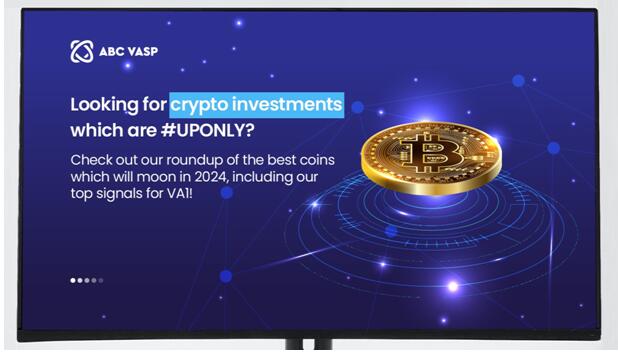 NOT COMPLIANT: Suggesting returns are guaranteed.
NOT COMPLIANT: Suggesting returns are guaranteed.
The above is a screen capture from a 30-second television advertisement by ABC VASP. “Looking for crypto investments which are #UPONLY” and “…best coins which will moon in 2024” are both messages which suggest that ABC VASP can provide guaranteed returns on its clients’ investments.
This advertisement is therefore in breach of Marketing Regulation I.C.2.e, which prohibits all Marketing from stating or implying that investment returns are guaranteed.
Figure (2): Screen capture of disclaimer in television advertisement
 NOT COMPLIANT: Disclaimer does not contain the information required.
NOT COMPLIANT: Disclaimer does not contain the information required.
At the end of the same television advertisement as the one in Figure (1), the visual in Figure (2) above is shown for three seconds.
(i) include a prominent disclaimer that Virtual Assets may lose their value in full or in part and are subject to extreme volatility; and (ii) state clearly that the owner and/or investor in the Virtual Asset can lose all the money or other value they invest and do not benefit from any form of financial protection.
The following updated disclaimer would comply with the above requirements: “Not financial advice. Crypto is highly volatile and may drop in value significantly. You may lose the amounts you invest and your investments do not benefit from any form of financial protection.” This disclaimer must also be displayed prominently in relation to the Marketing content (see guidance on “prominent disclaimer” in Part I of this Guidance on Marketing Regulations).
2. CEO Online Q&A
Figure (3): Screen capture of webpage showing CEO Q&A hosted by ABC VASP
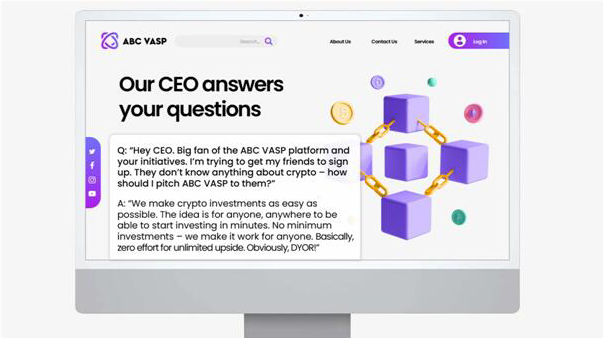 NOT COMPLIANT: Suggesting investment decisions are trivial, simple or easy without reference to risk of loss.
NOT COMPLIANT: Suggesting investment decisions are trivial, simple or easy without reference to risk of loss.
ABC VASP hosted an online Q&A with its CEO answering questions submitted by the community. The webpage is publicly accessible (i.e. no registration or sign up required).
It is apparent that the main message in the CEO’s response is to “pitch” ABC VASP to individuals who “don’t know anything about crypto”. This qualifies as Marketing.
Provided that all details are accurate, fair, clear and not misleading then the CEO’s description of features of the service, such as “No minimum investments” and “start investing in minutes”, are permissible.
However, the message of “zero effort for unlimited upside” does not satisfy the requirements of the Marketing Regulation I.C.2.f that Marketing must not imply that investment decisions are trivial, simple, or easy. It is also inconsistent with the fact that investments may lose their value (Marketing Regulation I.C.2.c).
Overall, this Q&A response does not present a balanced picture of the potential risks and returns involved in investing in Virtual Assets or using ABC VASP’s services.
3. Billboard Advertisement
Figure (4): Billboard advertisement displayed in public areas in Dubai
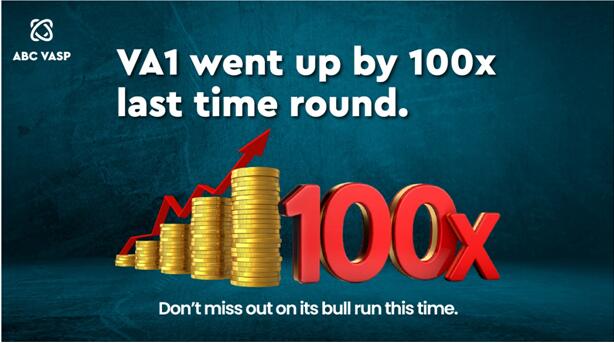 NOT COMPLIANT: Implies past performance guarantees future results and creates an urgency to acquire VA1.
NOT COMPLIANT: Implies past performance guarantees future results and creates an urgency to acquire VA1.
ABC VASP has put up the above billboard advertisement in various public areas in Dubai. The contents of the billboard advertisement are in breach of the following Marketing Regulations:
(i) Marketing must not state or imply that past performance of investments guarantees or is indicative of future results (Marketing Regulation I.C.2.g); and (ii) Marketing must not state or imply an urgency or create a fear of missing out on future appreciation in value or profits due to inaction (Marketing Regulation I.C.2.h).
4. References to past performance (Marketing Regulation I.C.2.g)
The billboard advertisement suggests the value of VA1 may go up by “100x”, as it had previously done so.
If Marketing content refers to the past performance of a Virtual Asset, it should at least include statements similar to the following to ensure that the reference is balanced out by appropriate qualifications:
(i) “The above information refers to the past performance of VA1 and is not a reliable indicator of its future performance.”; or (ii) “Investments can go up and down. Past performance is not necessarily indicative of future performance.”
Such statements should be presented legibly in the main part of the Marketing content in a font size that is easily read and in close proximity to the information about past performance.
The Marketing content should also clarify that any references to the past performance of a Virtual Asset does not guarantee or is indicative of future results.
5. Implying an urgency or creating a fear of missing out (Marketing Regulation I.C.2.h)
The billboard advertisement also calls for the audience to not “miss out on its bull run this time”. Such statement is clearly designed to create a fear of missing out on future appreciation.
Any messages of this nature should be presented in a balanced manner. This may include showing statements regarding the importance of careful consideration before signing up for, or using, a VASP’s service and that Virtual Assets may lose their value.
Given the Marketing content is presented in the form of a billboard advertisement and that the target audience will not be able to read its content in detail, it is very unlikely that the necessary messages and disclaimers would be able to be presented in balanced manner in the overall context of the Marketing. As such, these messages may be better suited to other media or channels which are considered by recipients for a longer period of time. Entities carrying out Marketing should always carefully consider whether a particular medium or channel is suitable for a particular message.
B. Case Study – Physical Events and Trade Shows in the Emirate
1. Event organiser
An event organiser is planning to set up a virtual assets exhibition, convention, seminar or conference (or any form of B2B/B2B2C event) held in the Emirate, which aims to bring together global leaders in the virtual asset industry, investors, and technology enthusiasts. In preparation of the event, the organiser should make sure that it complies with applicable requirements in the Marketing Regulations, including, but not limited to, Marketing Regulation I.F.2.
For example, the event organiser should:
(i) Ensure that all attendees are suitable and/or qualified to attend the event, depending on the nature and focus of the event (e.g. the audience for a virtual assets event focusing on institutional investment opportunities should be very different from a hackathon); and (ii) ensure it can, upon request, demonstrate to VARA how it complies, or has complied with, all requirements applicable to event organisers in the Marketing Regulations.
2. Event exhibitors
During the event, exhibitors may engage with potential clients and investors in many ways. It is not always clear that these practices are promotional in nature or have a “marketing” element. Below are some examples of common practices at events and trade shows, and related implications in the context of the Marketing Regulations:
a. Booth presentations
Exhibitors may set up booths to showcase their platforms, products, and services. These may include products and services that constitute VA Activities regulated by VARA. The booths utilise visually appealing displays to attract attendees (e.g. large logos of the business and Virtual Assets).
Figure (5): Booth of ABC VASP at a virtual asset event in Dubai
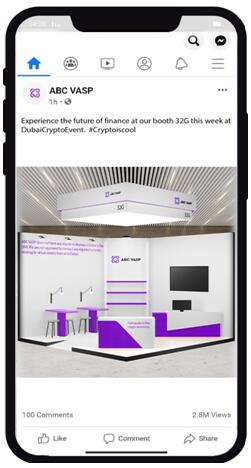 Key considerations: If an exhibitor is not Licensed by VARA, it should be careful when designing booth presentations to only present its name, logo, and types of activities provided, in accordance with Marketing Regulation I.F.1.
Key considerations: If an exhibitor is not Licensed by VARA, it should be careful when designing booth presentations to only present its name, logo, and types of activities provided, in accordance with Marketing Regulation I.F.1.
All Marketing conducted by Entities not Licensed by VARA should also include a prominent disclaimer that they are not Licensed or regulated by VARA, and hence not permitted to conduct VA Activities in the Emirate of Dubai.
Exhibitors that are not Licensed by VARA must also ensure they do not permit any residents of the UAE to sign-up, or onboard as a client, at the event (Marketing Regulation I.F.1.b).
Staff manning the booth should be reminded and trained on such requirements, in particular not to assist or solicit event attendees in signing up to its platform or onboarded as a customer (Marketing Regulation I.F.1.a) or make false claims about the licensing status of the exhibitor (whether under VARA or in other jurisdictions).
b. Panel discussions and presentations
Exhibitors may arrange for representatives to participate in panel discussions or deliver presentations throughout the event to share insights, industry trends, and the benefits of their platforms or services. These discussions and presentations may also be streamed online with various overlays (e.g. logos of event sponsors).
Figure (6): Panel discussion at a virtual asset event in Dubai
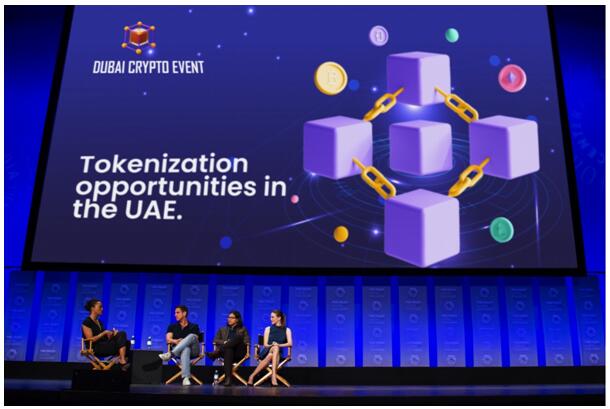 Key considerations: Participation in panel discussions and presentations would not be in breach of the Marketing Regulations, however the discussions should focus only on providing informative content and knowledge. Speakers are permitted to explain the features or provide other information about a product or service, but must not make any recommendations with respect to any product or service or Virtual Asset.
Key considerations: Participation in panel discussions and presentations would not be in breach of the Marketing Regulations, however the discussions should focus only on providing informative content and knowledge. Speakers are permitted to explain the features or provide other information about a product or service, but must not make any recommendations with respect to any product or service or Virtual Asset.
c. Branded merchandise and stationery
Branded merchandise and stationery, such as USB drives, pens, power banks, and articles of clothing/lifestyle are often distributed by exhibitors at events to increase brand visibility and for engagement with event attendees – including at charity events.
Figure (7): Branded stationery handed out by a VASP at an event in Dubai
 Key considerations: Promotional giveaways may be a form of non-monetary incentive. If these are used in the context of Marketing, they must not be used in such a way that they are likely to divert or mislead investors’ focus from the proper consideration of the product or service being promoted, as required under Marketing Regulation I.C.2.l.i (also see VI. Case Study – Incentives).
Key considerations: Promotional giveaways may be a form of non-monetary incentive. If these are used in the context of Marketing, they must not be used in such a way that they are likely to divert or mislead investors’ focus from the proper consideration of the product or service being promoted, as required under Marketing Regulation I.C.2.l.i (also see VI. Case Study – Incentives).
Generally, the lower the monetary value of the incentive offered, the more likely it is for the distribution of the incentive to be compliant with Marketing Regulation I.C.2.l.i and the above are all examples of permissible materials.
However, exhibitors should note that only handing out branded merchandise as an incentive to individuals to sign up to their platform is not compliant with Marketing Regulation I.C.2.l.i, as those individuals may be incentivised by the freebies to sign up, without giving proper consideration of the product or service offered by a particular exhibitor.
Exhibitors should also note that virtual asset airdrops at events may qualify as Marketing of, or relating to, a Virtual Asset, and therefore subject to certain rules in the Marketing Regulations as described below.
d. Promotions of virtual assets
Exhibitors may use virtual assets to promote themselves during an event, such as by handing out flyers with QR codes that allow NFTs to be minted insofar as they comply with the conditions below.
Figure (8): Pamphlet handed out at a virtual asset event in Dubai
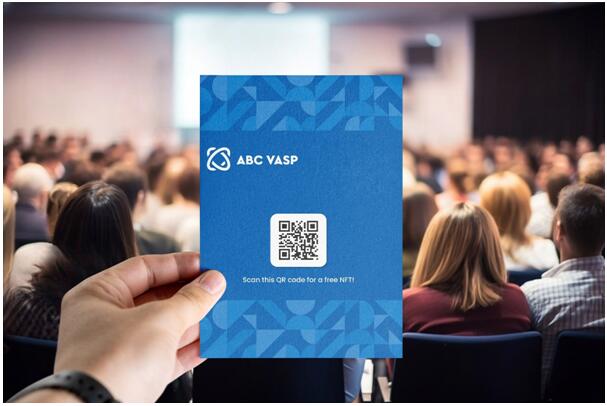 Key considerations: Such promotions would qualify as Marketing of, or relating to, a Virtual Asset and must therefore comply with Marketing Regulation I.C.3.
Key considerations: Such promotions would qualify as Marketing of, or relating to, a Virtual Asset and must therefore comply with Marketing Regulation I.C.3.
These requirements include seeking prior consent or expression of interest from the owner of the VA Wallet to the receipt of the Virtual Assets prior to any transfer. In this example, the recipient would need to take the action of scanning the QR code and click a condition that confirms his/her interest to receive the free NFT, in order to satisfy the requirement of an expression of interest.
Marketing Regulation I.C.3 also requires appropriate disclaimers to be made. This may be done by including statements on accompanying materials, such as a disclaimer on the pamphlet on which the airdrop QR code is displayed and/or on any relevant websites. As there is no disclaimer on the pamphlet in Figure (8), the webpage to which the QR code is linked must display a relevant disclaimer.
Entities in the UAE that issue any Virtual Asset must ensure they comply with all applicable Rules in the VA Issuance Rulebook.
e. Distribution of Marketing materials
Exhibitors may distribute various Marketing materials at the event venue or at satellite events. These include brochures, whitepapers, or newsletters.
Key considerations: The exemption in Marketing Regulation I.F which allows for Entities that are not Licensed by VARA to carry out Marketing of or relating to Virtual Assets or VA Activity is limited to physical events in the Emirate. Exhibitors must therefore ensure that they do not distribute such materials outside of the event, e.g. outside the event or after the event has ended.
f. Demonstrations and workshops
The event may host live demonstrations or interactive workshops to showcase the functionality and benefits of Virtual Assets and/or DLT. These sessions aim to educate attendees and provide hands-on experiences.
Key considerations: Demonstrations and workshops can comply with the Marketing Regulations if they focus on providing educational content and demonstrating the features and capabilities of Virtual Assets, a service and/or DLT. These sessions should not require attendees to sign up to use any particular service or acquire any Virtual Assets – i.e. no database of the attendees should be collected for future marketing/promotions/sales purposes.
C. Case Study – Journalistic Content
Below is a news report published by DubaiCryptoReporter, a fictional news website operating in Dubai. For the purposes of this case study, assume: (i) DubaiCryptoReporter is appropriately licensed in the UAE to operate an online news and media service with a focus on the virtual assets industry; and (ii) no other licences are required by DubaiCryptoReporter to operate its platform and publish the article in Figure (9) below.
Figure (9): Online news article published by DubaiCryptoReporter
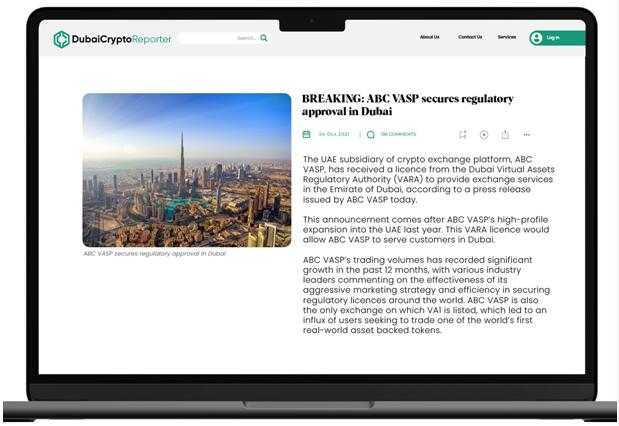 COMPLIANT: Overall purpose is clearly not marketing.
COMPLIANT: Overall purpose is clearly not marketing.
It is apparent that the overall purpose of this article is to report on the fact that ABC VASP has received a Licence from VARA to provide Exchange Services in Dubai. Although there are references to ABC VASP’s service offerings and the VA1 which is listed on the exchange, these serve to provide additional context, rather than to market or promote ABC VASP or the VA1. This article therefore falls within the journalistic exemption in Marketing Regulation I.D.1.
At the end of the article, the following disclaimer is displayed in the same font as the main body of the article:
Figure (9a): Disclaimer in online news article published by DubaiCryptoReporter
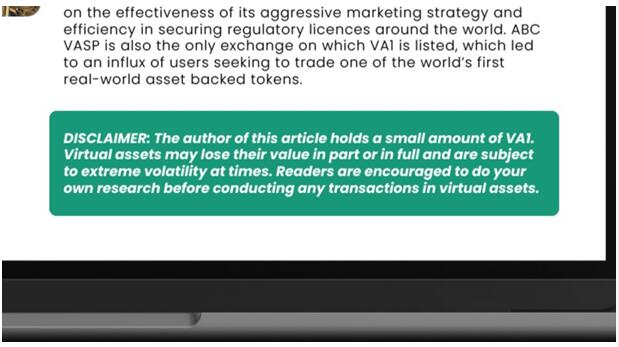 COMPLIANT: Prominent disclaimer of author’s holding of a virtual asset, as well as volatility and risk of total loss.
COMPLIANT: Prominent disclaimer of author’s holding of a virtual asset, as well as volatility and risk of total loss.
(i) explanation of the nature of the author’s interest in any Virtual Asset, VA Activity and/or VASP to which the content relates; and (ii) if the content refers to the purchase of a Virtual Asset, a disclaimer that Virtual Assets may lose their value in part or in full and are subject to extreme volatility at times.
In terms of presentation, disclaimers should be shown in a form equal to or more prominent than the form of the content itself (see guidance on “prominent disclaimer” in Part I of this Guidance on Marketing Regulations).
The text in the green box in Figure (9a) is an example of a compliant disclaimer.
D. Case Study – Educational Content
The below is a fictional example of educational content published by a website under their “Learn” section.
Figure (10): “Learn” section of the website of ABC VASP
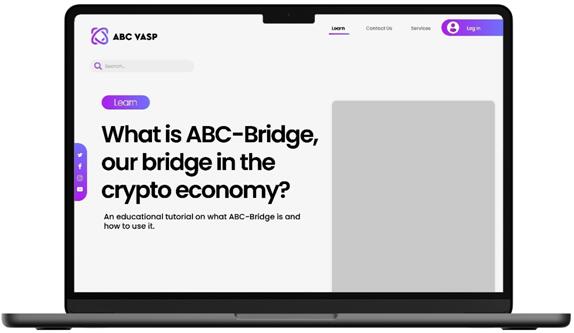 COMPLIANT: Overall purpose is clearly not Marketing.
COMPLIANT: Overall purpose is clearly not Marketing.
As the article is intended to be an “educational tutorial”, this may qualify under the educational exemption in Marketing Regulation I.D.2, provided that the requirements explained below are also complied with.
If the tutorial includes information on how to purchase a Virtual Asset to use the “ABC-Bridge”, the content must include a disclaimer that Virtual Assets may lose their value in part or in full and are subject to extreme volatility at times. Again, such disclaimers should be prominent (see guidance on “prominent disclaimer” in Part I of this Guidance on Marketing Regulations).
Figure (11): Disclaimer in “Learn” section of the website of ABC VASP

COMPLIANT: Prominent disclaimer on volatility of virtual assets and risk of total loss.
For the purpose of this example, assume the author of the content in Figure (10) does not have any interest in any Virtual Asset mentioned in the tutorial, but the tutorial does include references to the purchase of Virtual Assets.
Under Marketing Regulation I.D.2.d, the tutorial must then include a prominent disclaimer that Virtual Assets may lose their value in part or in full and are subject to extreme volatility at times. The text in the green box in Figure (11) is an example of a compliant disclaimer.
E. Case Study – Influencers / Key Opinion Leaders (KOLs)
DubaiCryptoGuy is a fictional social media influencer based out of Dubai with a significant online following. The influencer has recently entered into a paid partnership with ABC VASP to promote its services.
Figure (12): Fictional social media profile of influencer based out of Dubai
 COMPLIANT: Reference to certain posts being sponsored (but note each sponsored post should also be clearly labelled as explained further below).
COMPLIANT: Reference to certain posts being sponsored (but note each sponsored post should also be clearly labelled as explained further below).
In Figure (12), the influencer’s social media bio contains a statement that the profile may contain sponsored posts. This is an example if good practice for the home page of a profile however, as explained further below, it is not sufficient to qualify as a clear and prominent indication of which posts are sponsored by ABC VASP.
In order to comply with Marketing Regulation I.C.2.k, the influencer should also include a clear statement in the caption of each post sponsored by ABC VASP that those posts are made as part of a remunerated arrangement with ABC VASP.
As the posts sponsored by ABC VASP are likely to relate to VA Activities conducted by ABC VASP, DubaiCryptoGuy must ensure that all sponsored Marketing is conducted on behalf of, and approved by, ABC VASP. It is the influencer’s responsibility to confirm with ABC VASP that it is Licensed by VARA to carry out the VA Activity(ies) to which the Marketing relate.
Below are further examples of non-compliant sponsored posts on social media:
Figure (13): Sponsored social media post by influencer based out of Dubai
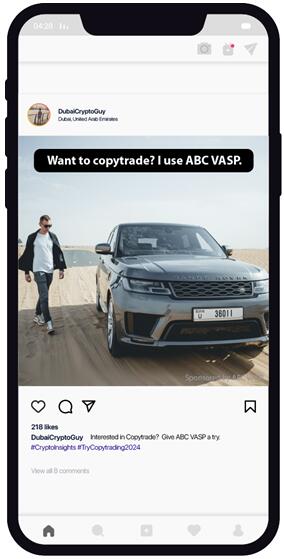 NOT COMPLIANT: Indication of sponsored post not clear and prominent (hidden in lower right corner of image).
NOT COMPLIANT: Indication of sponsored post not clear and prominent (hidden in lower right corner of image).
Figure (13) shows a sponsored social media post which does not include a clear and prominent indication of a sponsorship. While the image contains the wording, “Sponsored by ABC VASP”, in the bottom right corner, this statement is not clearly visible or easy to spot against the background of the image.
Figure (14): Sponsored social media post by influencer based out of Dubai
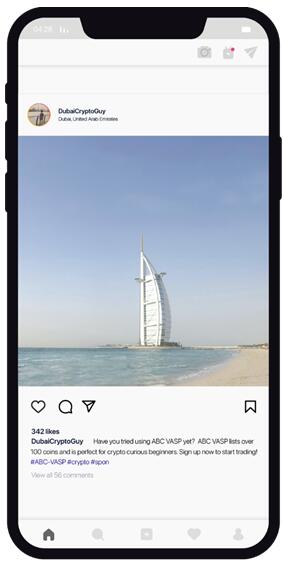 NOT COMPLIANT: #spon is not a clear and prominent indication that this post is sponsored.
NOT COMPLIANT: #spon is not a clear and prominent indication that this post is sponsored.
Figure (14) shows a sponsored social media post which is not clearly identifiable as paid or sponsored content. Although the caption includes a hashtag stating the name of ABC VASP (“#ABC-VASP”), it does not contain any wording that clearly indicate that the post is sponsored by ABC VASP.
In particular, the hashtag “#spon” (intended to be short for “#sponsored”) in the caption of the post is not sufficient to clearly identify the post is sponsored or paid content.
F. Case Study – Incentives
The examples below highlight potential issues arising from the use of monetary or non-monetary incentives in Marketing campaigns.
1. Referral programme
ABC VASP is launching a referral programme to acquire new customers in the Emirate, after receiving a VARA Licence for providing Exchange Services. The programme allows existing users to share referral codes with any person, with no maximum number of referrals. Once a person signs up with ABC VASP the referrer gets a fixed percentage of trading fees generated by users that sign up using their referral code.
i. ABC VASP’s referral programme would need to be approved by VARA as part of its licensing application and ABC VASP must comply with all conditions imposed by VARA when giving that approval or any later time.
2. Free non-tradeable NFT
ABC VASP is also launching its own NFT marketplace. To attract users, it has announced that users who sign up in the next month will be gifted a free, non-tradeable NFT as a digital collectible commemorating the launch of the marketplace.
In its Marketing campaign for the NFT marketplace, ABC VASP has focused on promoting its low fees and policy on royalties (i.e. features of the platform).
An example of ABC VASP’s Marketing of the new NFT marketplace is shown below.
Figure (15): Social media post by ABC VASP
 COMPLIANT: Free, non-tradeable NFTs are unlikely to divert investors’ focus from considering the risks associated with using the NFT marketplace.
COMPLIANT: Free, non-tradeable NFTs are unlikely to divert investors’ focus from considering the risks associated with using the NFT marketplace.
The free non-tradeable NFT for early users qualifies as a non-monetary incentive used in the Marketing of ABC VASP. Monetary and non-monetary incentives are subject to requirements in Marketing Regulation I.C.2.l.
As the NFT in this specific instance is minted for commemorative purposes only and has a negligible economic value as it cannot be traded, this giveaway is unlikely to divert potential users’ focus from the proper consideration of the risks associated with using the NFT marketplace or trading NFTs as a whole. The NFT giveaway is therefore a compliant form of non-monetary incentive used in Marketing.
G. Case Study – Promotion of a Virtual Asset
The below are fictional examples of promotional materials relating to VA1, a Virtual Asset. Issuers of Virtual Assets are reminded that they must comply with all applicable Rules in the VA Issuance Rulebook when conducting Marketing, including, but not limited to, Rules regarding Whitepaper disclosures.
1. VA1 Homepage
Figure (16): “About VA1” webpage
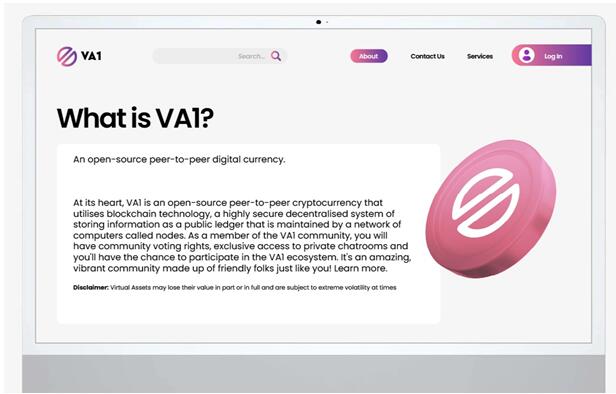 COMPLIANT: Factual presentation of key features; no invitation to buy; prominent disclaimer.
COMPLIANT: Factual presentation of key features; no invitation to buy; prominent disclaimer.
The above webpage introduces key features and rights attached to VA1 in a factual manner. This information is presented accurately and truthfully (e.g. based on how relevant smart contracts function). There is no “call to action” inviting the public to buy VA1, nor any information regarding how VA1 can be bought. A prominent disclaimer stating that “Virtual Assets may lose their value in part or in full and are subject to extreme volatility at times” is displayed. A webpage which satisfies all of the above is therefore an acceptable way to present information regarding a Virtual Asset in compliance with the Marketing Regulations.
2. VA1 Social media post
Figure (17): Social media post by VA1 team
 NOT COMPLIANT: Overall message is designed to solicit trading of a virtual asset. It also hints at near term increase in value and there is no disclaimer.
NOT COMPLIANT: Overall message is designed to solicit trading of a virtual asset. It also hints at near term increase in value and there is no disclaimer.
The above is posted by VA1’s social media account and alerts followers to the imminent listing of VA1 on ABC VASP. The post also mentions a protocol update which is due the following month. Provided these statements are true and not misleading, these types of information are allowed and may be used in Marketing. However, when used in combination with other parts of the content in this example, this post is not compliant with the Marketing Regulations explained further below.
VARA will consider the overall message conveyed in all Marketing. Both words and other ways of communicating, including emojis, will be considered in the context in which they are used. In this example, the phrase “Who’s getting ready to trade?” and the rocket emojis, when used in the overall context of this post, imply an urgency to acquire VA1 in anticipation of the listing and the protocol upgrade leading to an imminent future appreciation in value. As such, this post does not comply with general requirements for Marketing as set out in Marketing Regulation I.C.2.
For the avoidance of doubt, this does not mean emojis, and in particular the rocket emoji, cannot be used in all cases. The meaning a word or emoji has, depends on the context in which it is used, and provided the overall message conveyed does not infringe the Marketing Regulations, then no single word or emoji is prohibited.
The lack of disclaimers regarding the potential volatility of VA1 means the post is also inconsistent with the message that Virtual Assets may lose their value in part or in full and are subject to extreme volatility at times.
3. Podcast appearance by developers behind VA1
A developer behind VA1 makes an appearance on a podcast to discuss the imminent launch of VA1. Assume the discussion is primarily focused on the key features of VA1 and its underlying DLT, until the interviewer asks the developer “why should listeners buy VA1?” While the developer can provide an answer to this question, any such discussion is likely to constitute Marketing and therefore must comply with general requirements applicable to all Marketing in Marketing Regulation I.C.2 and specific requirements applicable to all Marketing of Virtual Assets in Marketing Regulation I.C.3. This means that the developer must not, among other things, advocate that buying VA1 is a low-risk investment, imply that past performance of the price of Virtual Assets similar to VA1 guarantees or is indicative of the future price of VA1, or communicate any misleading or inaccurate information.
The producers of the podcast and/or similar Entities are also responsible for ensuring compliance with Marketing Regulation I.C.3 (e.g. by including a prominent disclaimer that Virtual Assets may lose their value in part or in full and are subject to extreme volatility at times) and Marketing Regulation I.E.1 (e.g. by taking reasonable steps to ensure the podcast episode and VA1 itself comply with all applicable laws, regulations, guidelines or other rules applicable across the UAE, and specific to the Emirate).
4. Online chatroom maintained by the issuer of VA1
Figure (18): Online chatroom maintained by the issuer of VA1
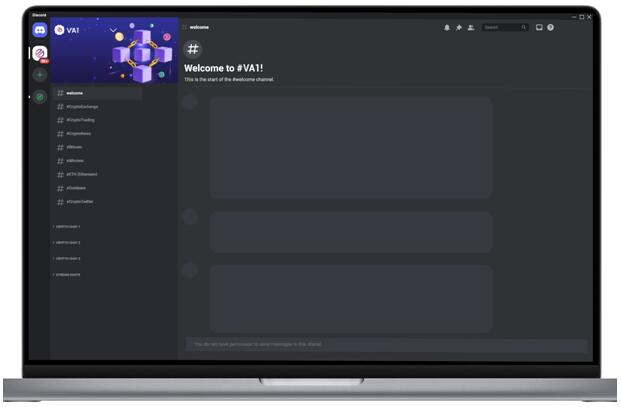 The issuer of VA1 maintains an online chatroom for community engagement, and official announcements. From time to time, developers behind VA1 may drop in and chat with the community.
The issuer of VA1 maintains an online chatroom for community engagement, and official announcements. From time to time, developers behind VA1 may drop in and chat with the community.
Depending on their context and content, messages in the chatroom may constitute Marketing. For example, if a developer sends messages in the chatroom regarding an upcoming airdrop of VA1, these may constitute Marketing of a Virtual Asset. As such, the developer must ensure that a disclaimer that Virtual Assets may lose their value in part or in full and are subject to extreme volatility at times is displayed prominently in relation to those messages (e.g. by sending this disclaimer immediately before or after the Marketing messages). These Marketing messages must also comply with general requirements in Marketing Regulation I.C.2.
Schedule 1 – Definitions
Term Definition “Directive” has the meaning ascribed to it in the Regulations. “Distributed Ledger Technology” or “DLT” has the meaning ascribed to the term “Distributed Ledger Technology” in the Dubai VA Law. “Dubai VA Law” means Law No. (4) of 2022 Regulating Virtual Assets in the Emirate of Dubai, as may be amended from time to time. “Emirate” means all zones across the Emirate of Dubai, including Special Development Zones and Free Zones but excluding the Dubai International Financial Centre. “Entity” means any legal entity or individual. “Exchange Services” has the meaning ascribed to it in Schedule 1 of the Regulations. “Guidance” has the meaning ascribed to it in the Regulations. “Guidance on Marketing Regulations” means this Guidance on Regulations on the Marketing of Virtual Assets and Related Activities 2024, as may be amended from time to time. “Licence” has the meaning ascribed to it in the Regulations. “Licensed” means having a valid Licence. “Marketing” has the meaning ascribed to it in Marketing Regulation I.A.1. “Marketing Regulations” means the Regulations on the Marketing of Virtual Assets and Related Activities 2024. “Regulations” means the Virtual Assets and Related Activities Regulations 2023, as may be amended from time to time. “Rule” has the meaning ascribed to it in the Regulations. “UAE” means the United Arab Emirates. “VA Activity” means the activities listed in Schedule 1 of the Regulations, as may be amended from time to time. “VA Issuance Rulebook” means the Virtual Asset Issuance Rulebook issued by VARA pursuant to the Regulations, as may be amended from time to time. “VA Wallet” has the meaning ascribed to the term “Virtual Asset Wallet” in the Dubai VA Law. “VARA” means the Dubai Virtual Assets Regulatory Authority. “VASP” means an Entity authorised by VARA to conduct VA Activity(ies) in the Emirate. “Virtual Asset” or “VA” has the meaning ascribed to it in the Dubai VA Law.